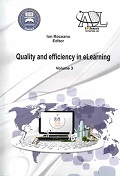TEACHING CAD APPLICATIONS WITH SIMULATED INTERACTIVE LESSON
TEACHING CAD APPLICATIONS WITH SIMULATED INTERACTIVE LESSON
Author(s): Mirela Blaga, Ana-Ramona CiobanuSubject(s): Education
Published by: Carol I National Defence University Publishing House
Keywords: Computer Aided Design; Spacer knitted fabrics; Simulated interactive lesson
Summary/Abstract: Simulation plays an important role in developing e-learning tools for teaching technical contents. Nowadays, the advanced textile technologies are based on Computer Aided Design (CAD) activity performed with specialised software, where programming skills are achieved by a sustained training. Working time in the knitting laboratory is sometimes constrained by either student schedule or PC availability. More, the high investment in such software limits its acquisition at personal level. Therefore, creating alternatives for self training and assessment increases the quality of the education in a specialised field and gives independence to the learner. “Storyline” software from Articulate offers an IT solution for building interactive simulations of the lessons, accessible on the student environment. What makes the difference between similar solutions is the existing active buttons, exclusively for the presented lesson, as part of the recorded computer screen activity. In this context, the paper focuses on the teaching CAD applications, regarding the design of spacer knitted fabrics, made on M1 plus pattern station, from Stoll GmbH, Germany. Technical data, such as: machine class and type, fabric structures, panel dimensions, stitch densities, yarn careers, machine setup are explained, following the main steps of programming. This class of fabrics can be produced on electronic flat knitting machines, under advantageous economic conditions, by exploiting the simplified manufacturing process, the high quality of the product and lower costs with the machinery. Due to the advantage of the modern technology, the properties of the spacer fabrics can be engineered, by using different types of structures, raw materials, and finishing processes.
Journal: Conference proceedings of »eLearning and Software for Education« (eLSE)
- Issue Year: 9/2013
- Issue No: 03
- Page Range: 344-349
- Page Count: 6
- Language: English

